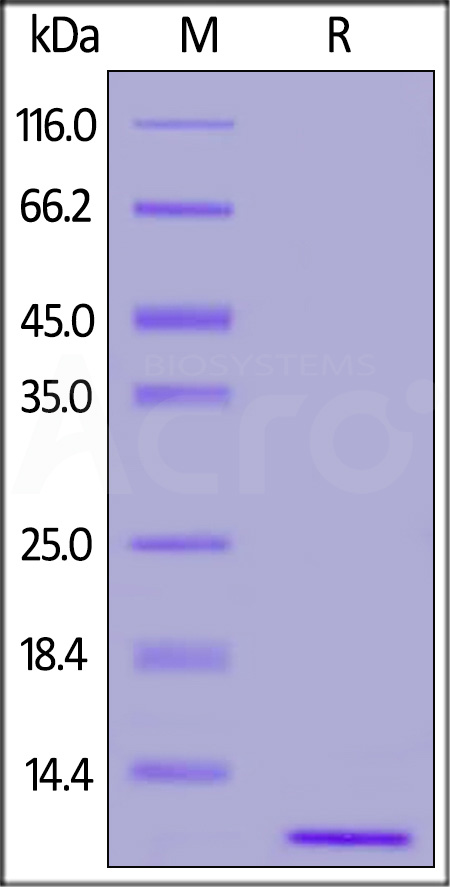分子别名(Synonym)
S100B,NEF,S100,S100beta
表达区间及表达系统(Source)
Human S100B, His Tag (S1B-H5143) is expressed from E. coli cells. It contains AA Ser 2 - Glu 92 (Accession # NP_006263).
Predicted N-terminus: Met
Request for sequence
蛋白结构(Molecular Characterization)

This protein carries a polyhistidine tag at the N-terminus
The protein has a calculated MW of 11.5 kDa. The protein migrates as 11 kDa under reducing (R) condition (SDS-PAGE).
内毒素(Endotoxin)
Less than 1.0 EU per μg by the LAL method.
纯度(Purity)
>95% as determined by SDS-PAGE.
制剂(Formulation)
Lyophilized from 0.22 μm filtered solution in 50 mM Tris, 150 mM NaCl, pH8.0 with trehalose as protectant.
Contact us for customized product form or formulation.
重构方法(Reconstitution)
Please see Certificate of Analysis for specific instructions.
For best performance, we strongly recommend you to follow the reconstitution protocol provided in the CoA.
存储(Storage)
For long term storage, the product should be stored at lyophilized state at -20°C or lower.
Please avoid repeated freeze-thaw cycles.
This product is stable after storage at:
- -20°C to -70°C for 12 months in lyophilized state;
- -70°C for 3 months under sterile conditions after reconstitution.
电泳(SDS-PAGE)

Human S100B, His Tag on SDS-PAGE under reducing (R) condition. The gel was stained with Coomassie Blue. The purity of the protein is greater than 95%.
背景(Background)
S-100 protein beta chain (S100B),a member of the S-100 family, is also known as S-100 protein subunit beta and S100 calcium-binding protein B, which contains two EF-hand domains. S100B can weakly bind calcium but bind zinc very tightly-distinct binding sites with different affinities exist for both ions on each monomer. Also, S100B can bind to and initiate the activation of STK38 by releasing autoinhibitory intramolecular interactions within the kinase. Interaction with AGER after myocardial infarction,S100B may play a role in myocyte apoptosis by activating ERK1/2 and p53/TP53 signaling. Fuethermore,S100B could assist ATAD3A cytoplasmic processing, preventing aggregation and favoring mitochondrial localization. S100B may mediate calcium-dependent regulation on many physiological processes by interacting with other proteins, such as TPR-containing proteins, and modulating their activity.























































 膜杰作
膜杰作 Star Staining
Star Staining











